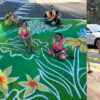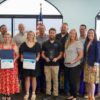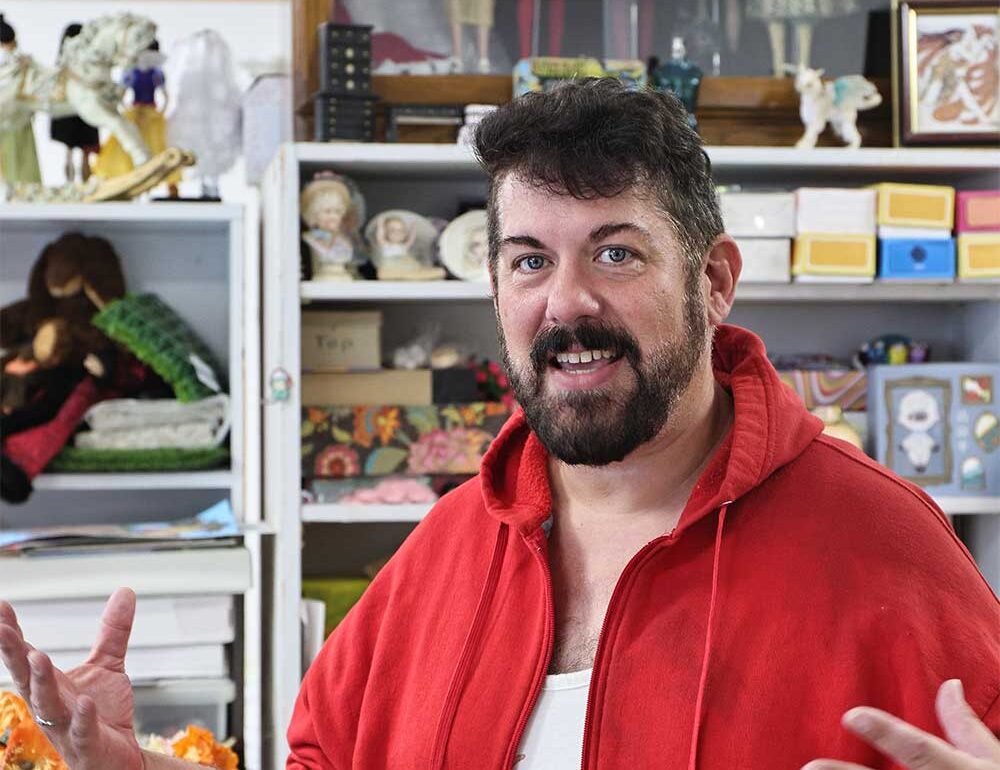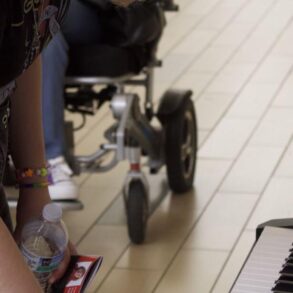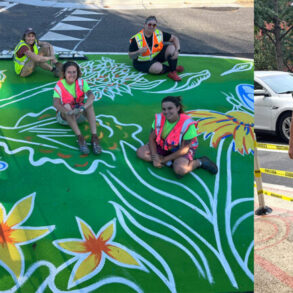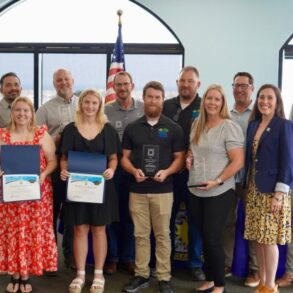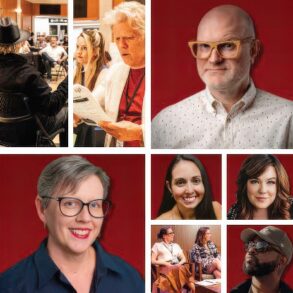Matt and Emily Free Wilson have a reputation for taking risks. In the 20 years that they’ve been married, the couple traded in their Subaru for a Volkswagen bus, started a ceramics business, and bought a funeral home in Helena, Montana that they renovated into their first foray into a community art center.
The Wilsons are so spontaneous, in fact, that when Emily recently posted a picture about her trip to the zoo, her friends and family were quick to half-tease in asking whether they had bought it for their next adventure. “They were like, ‘You bought a zoo?!’” Matt recalls.
So it was hardly a surprise when, in 2019, Matt and Emily uprooted their entire lives once again. But they didn’t simply move from Helena, Montana, to Gardiner, Oregon. They moved into an abandoned middle school on the slope of a hill in the center of the town across the mouth of the Umpqua River from Reedsport, and turned it into a nonprofit art haven: the Oregon Coast School of Art.
It is a behemoth gray and white building, standing two stories tall with a mezzanine. OCSA is incredibly wide as well, taking up multiple full city blocks and making the small surrounding houses look minuscule. When the Wilsons found the middle school, it had been empty and lifeless.
Today the Oregon Coast School of Art is a burgeoning creative community home to a variety of artistic endeavors. Many of its former classrooms now house art studios, businesses, art classes for children and adults alike — even a radio station. The rest of the rooms are held for events that can either be put on by the OCSA itself or artists in the community.
Previous events held in OCSA have been a dog sniffing contest and gem fairs. It also fosters many community endeavors, allowing people from near and far to arrive with their own dreams of creativity. The building overlooking the Umpqua River and nearby mountains serves as a picturesque, serene spot with windows lining the walls overlooking it all.
It all started when, either 15 or 17 years ago (they can’t remember), the couple pursued their own art business venture, Free Ceramics. Emily had been an artist for her entire life, with pottery as her first love.
Matt, on the other hand, was a full-time construction worker who had no interest in or knowledge of anything regarding art until he and Emily got together. “He figured out if he wanted to spend time with me he would have to start doing art,” Emily says with a chuckle. They gradually started working together, until Matt agreed to help Emily turn her hobby into a business.
After taking some art classes, they established an artistic routine that allowed them to complement each other. “Emily and I come up with an object that’s unique to us, and then I cast it, and then I’m able to remake that object with plaster and liquid clay,” Matt says.
“I kind of do a little bit of everything,” Emily says. She throws, hand builds and decorates the pieces. Their large and small porcelain vases, dishes and pots are marked with their signature bold and whimsical black lines that they fill with bright colors on a white background.
They began running the business in 2009 out of their small Helena studio with a big window.
But soon, they started dreaming bigger. The more they collaborated with other artists, taught classes and hosted exhibitions, the smaller the room felt.
The solution was simple: They bought a 9,000-square-foot funeral home. They flipped it completely into an art center, with ample room allowing them to run the thriving art center they had envisioned. They ran it for six years.
But everything changed when Emily’s fishmonger father gifted Matt an Oregon fishing license in 2019. That summer, the couple ended up in the Pacific Time zone five times over the course of three months. “The one thing that would get me out of Montana was to come out on the ocean for the big fish and have big fun,” Matt says. The more he came out to the coast, the further Oregon crept into his soul.
One summer day, when the stormy weather deemed the ocean unattainable, the Wilsons went hiking. Little did they know, that would be the first day of the rest of their lives.
On the way back from their hike, they passed through Gardiner. The tiny town between Florence and Coos Bay was once the largest employer on the coast. It was a prosperous lumber and trading town known as the “White City by the Sea,” where bustling ships zipped up the Umpqua River while its logging camps and paper mills would whirr and pump away in seemingly endless luster.
In 1999, the last mill shut down and people started moving away. Now, Gardiner is a quaint little coastal village with a population of about 250 people.
But when the Wilsons arrived in Gardiner, they saw nothing but beauty, with its mountains, trees, shops and cafes. The very large building that lay seemingly in the center of this community caught Matt’s eye.
The former W.F. Jewett Middle School is a 45,000-square-foot building that had sat empty in the small town since 2004. Emily noted the 4×8 “FOR SALE” sign sitting in front of it. There was just something about the building that immediately drew the Wilsons to it, and they booked an appointment with the real estate broker for the next day. “We’ve done that before and not like, totally changed our lives,” Emily says.
But while walking through the abandoned school, they saw their future laid out before them. “I don’t know how to explain it, other than if we didn’t do it, if we didn’t go for it, it would be that thing we would always wonder about,” Emily says.
They pulled the trigger and bought the place. That November, they sold their house, packed their things and Matt and Emily, who was pregnant with her second child — moved into the school with their then 12-year-old son.
With financial help from grants and friends, the Wilsons raised $22,000 every year for the first three years to bring the abandoned building to life. “When we decided to take on the school, we had a lot of experience doing this already, but we were ready to turn it into a nonprofit and get more people involved with it,” Emily says. It wasn’t until late 2023 that the Wilson family moved out of the building and into a house up the road, though the couple still have offices there (Emily’s is the former principal’s office).
Drawing on their separate strengths, Emily as an artist and Matt in construction, the Wilsons transformed the former middle school. Now it is a living city with a population within its walls.
The entry doors open into the school’s former cafetorium, which is now the official homebase to Free Ceramics. Across from their pottery is a stage original to the building, that the couple allows local bands to use as a practice space.
Walking down the halls and into classrooms, which sometimes have wood scraps and paint splatters from unfinished rooms and maintenance projects, means traipsing up the stairs and past the original red lockers and poignant artwork of the Jewett students of the past. The Wilsons have kept as much of the life of the original school as possible, down to the original teacher name cards above some of the doors. “We always want to make it feel like people are coming to an old school ready to learn,” Emily says. “Alumni come in and tell us all about it. It’s pretty cool.”
Aside from the nostalgia, the cubbies within classrooms serve as perfect storage for art supplies when artists use them as studios. Down the hall from the cafetorium are Matt and Emily’s separate art studios, containing kilns, slip casting materials, paints, clay and even raku (a type of Japanese clay firing) devices.
Starting in 2022, the Wilsons opened up OCSA as an artist-in-residence program. The program allows artists to rent a space within OCSA to live and create, for anywhere from two weeks to two years, drinking in the views of the mountains and rivers just outside their window, and enjoying the serenity of being in a small town. During their residencies, artists interact with each other, teach classes to children of the nearby Reedsport School District, and take part in community events. A room on the building’s third floor has been turned into a sleek, white-walled gallery space that the artists are encouraged to use for their own exhibitions.
“We just really want to be a safe, fun, creative and energized landing spot for artists for whatever length of time they need,” Emily says. “If you’re an artist and you have a full time job, but you want to go spend some time in a creative environment and focus on your art, it’s hard to find a space that can accommodate an artist for a short period of time.”
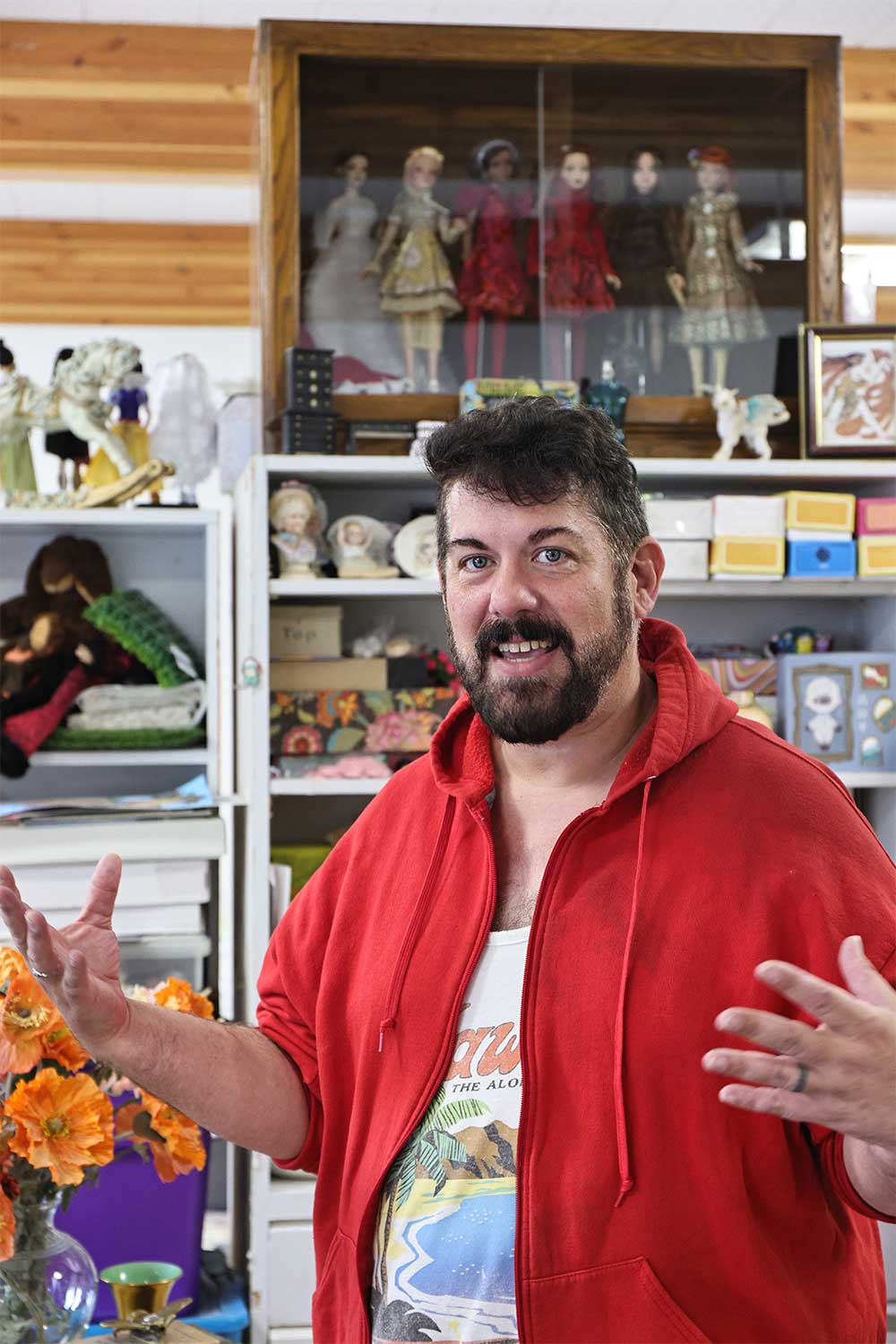
One artist who has benefitted from this is Joey Versaw.
Versaw’s room is an adult toy box full of dolls. “Adult,” because his eclectic array of dolls is busty, scantily clad, horrifying and wonderfully insane. Beautiful plastic trolls, babies, mermaids, fairies and clowns (naked and clothed alike) line the walls and fill glass cases throughout the space. They are all either 3D printed or sculpted of resin, filling the room with hundreds of unique and colorful artificial faces.
Versaw himself has eyes as sharp as his cheekbones, a soft voice and a thick brunette beard.
When Versaw was a little kid, he handmade paper dolls because he wasn’t allowed to have real ones. But that didn’t last for long. “I was 16 and I hit my rebellious years and I started collecting,” he says. “And my mom was like, ‘Well at least it’s not drugs.’ I said, ‘It kind of is.’” Eventually, he started sculpting dolls.
Now he is a nationally prominent figure in the indie doll community, making regular appearances in doll magazines, podcasts and conventions. He pioneered 3D printed fashion dolls with a 1950s Barbie-inspired character named “Miss Mary Magpie,” and also contributed to history by releasing a line of canonically gay male dolls. “Doll art is perfect for me because I’m so interested in fashion, and the human form and I love painting, and it all just came together.”
Versaw came upon Oregon Coast School of Art in early 2024. When his mother was diagnosed as terminally ill and his partner left him, “I was going through one of the worst periods of my life,” he says. Some months later, he got in a car accident. Feeling that his life was on the downturn, Versaw needed a place to start over. His best friend, who lived in Florence, suggested trying an OCSA residency. When he met with the Wilsons, they knew that he would fit right in with the school’s eccentric beauty and invited him to stay. “I was like OK, universe!” he says.
“With all the things that kind of happened at once, it’s taken me a little longer to get settled. But I’m back to it.”
Though he is early in his journey of adapting to this pitstop in his life he’s enjoying his stay. “It’s nice because it’s so rural. I love being outside of everything. And the view, of course, is very nice,” Versaw says.
But he admits that living in a large former classroom can be intimidating. “I’m used to living in apartments or houses, where you could squirrel stuff away in closets. But to just have this open space, I was like, ‘How am I going to do this?’” His floor-to-ceiling shelves of dolls divide the room in half, with his doll studio on one side and a makeshift living space on the other.
The artists in residence are supplied with a former classroom, furnished only with a kitchenette and a hot water heater. Their rent covers shared utilities, such as wi-fi, showers and laundry at the school. The Wilsons have extra furniture only if needed.
“I want their rooms to be a blank canvas,” Emily says. “I wanted the artists to do what they want with the space and have a break from their stuff or their visual clutter to come into a big, open, wide, white room with a view.”
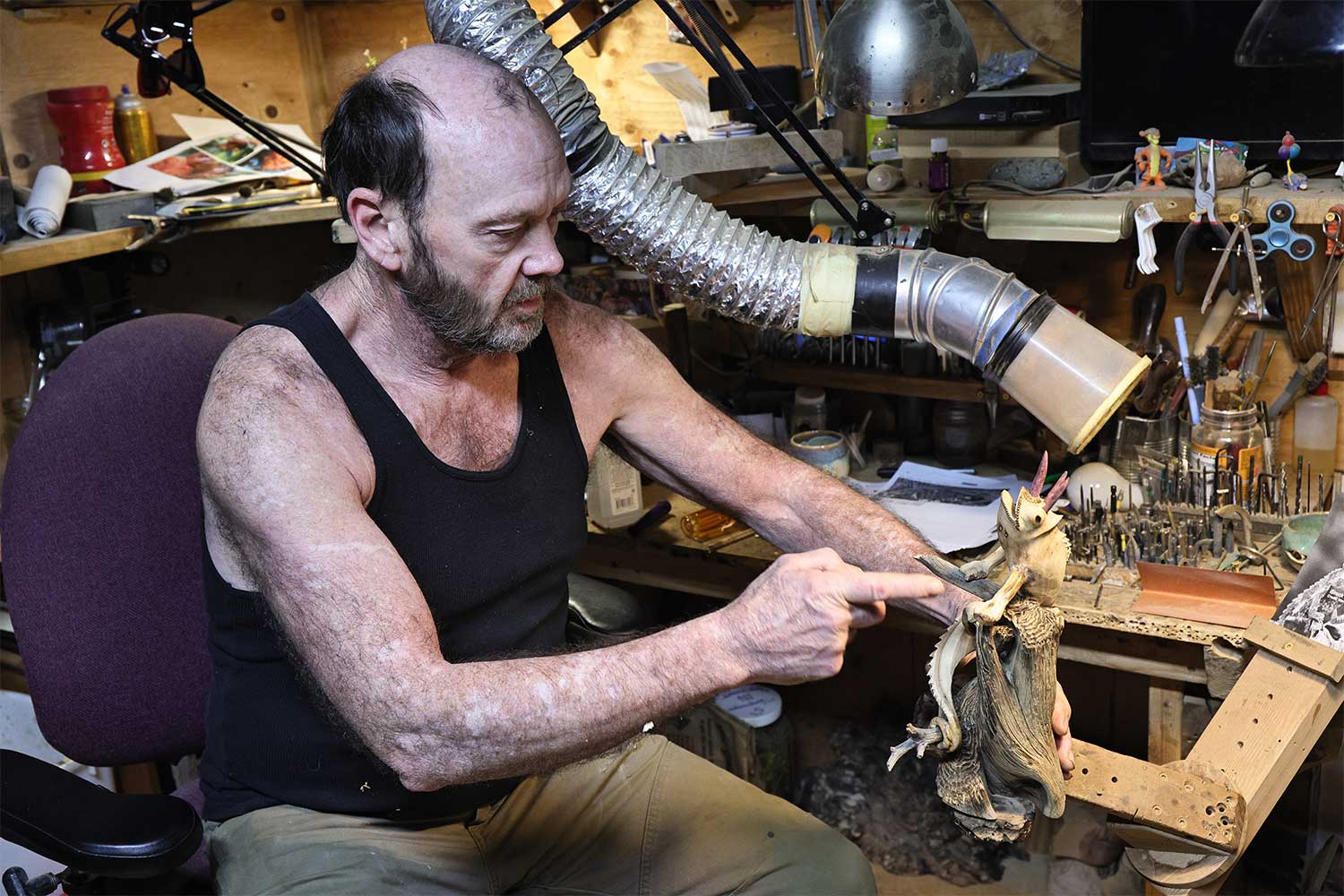
OCSA has provided space for artists, dollmakers, woodworkers, taxidermy shops and more, as well as, since 2021, the local Reedsport radio station, KDUN.
The KDUN radio station room is set up with two separate recording booths and six total computers. The wiring, transmitters and all of the technology equates to 50,000 watts of power, which is the highest wattage that the FCC allows for an AM radio station.
KDUN has been playing classic rock hits and reporting on local news in Reedsport since 1969, but in 2007 it went silent after financial problems saw electricity bills go unpaid. After that, KDUN spent time changing hands between various corporations, having an on-and-off relationship with syndication ever since.
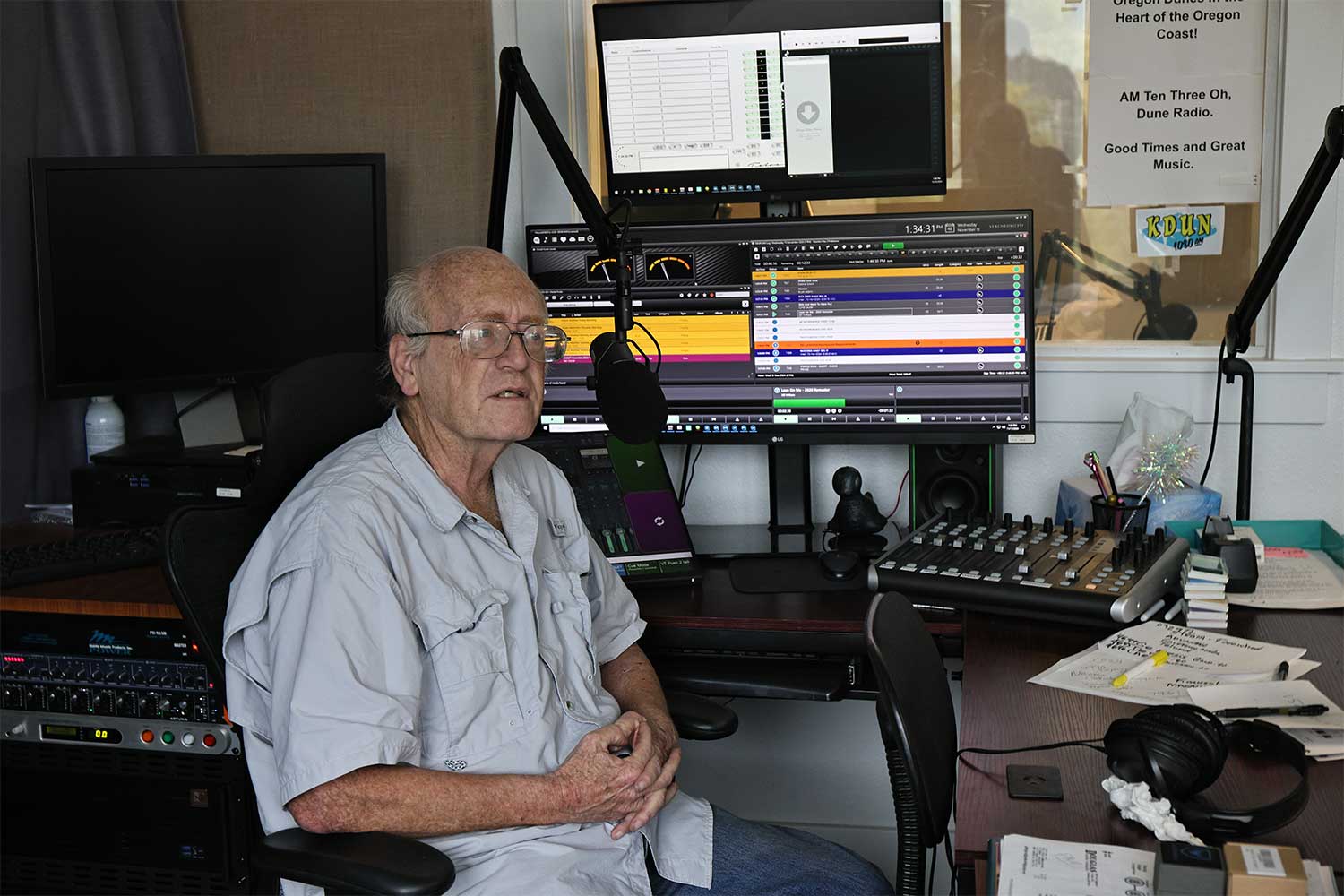
Another thing to know about Reedsport: it is the hometown of Delilah Rene, or “Delilah” as she is more well-known. Delilah is a Seattle-based radio personality known for her wildly popular, nationally syndicated eponymous call-in talk radio show — the one that Sleepless in Seattle is based on. Before she was famous, her very first radio experience was on KDUN as a teenager. In May 2021, she acquired the radio station.
Bob Larson, the older and robust disc jockey who currently oversees it, recalls visiting the radio station’s original location after Delilah initially asked him to help put it back on air by Labor Day weekend. “It was terrible. It was rat and mice infested. We went out there and opened up the big doors and they flew out everywhere,” Larson says. “Fortunately, they didn’t eat through the wiring harnesses.”
Suddenly in need of a new location for the station and with a broadcast premiere date only months away on the horizon, Delilah and Larson began frantically looking for a place to set up shop. That’s where the Wilsons came in. “It just happened to be right here,” Emily says.
When OCSA was decided, the community got to work turning the former classroom into a radio station. Volunteers showed up to paint, a local construction crew came in and reconfigured the room, “and everybody started getting nuts and wiring everything together trying to get everything set up,” Larson says, to ensure a timely broadcast. At the time, five people worked in the station for KDUN. After COVID, Larson is the only person physically there, but that hasn’t affected his work or the quality of the station.
“It’s been a really wonderful addition to the community here. We’re so lucky. How many small towns have their own radio station?” Emily says. “Communication is an art,” Matt adds.
Since then, KDUN has operated out of room No. 5 on the second floor of OCSA, which, coincidentally, was also Delilah’s 5th grade classroom. KDUN is local to Reedsport, but the region it covers goes up through Albany and down through Canyonville, which makes it useful for advertising OCSA’s events and projects during their weekly interviews.
The Wilsons’ driving force has always been their focus on creating, maintaining, and being involved in the community. Aside from giving artists a home, OCSA also hosts the Gardiner food pantry and the meeting space for the local Boy Scouts. They also call themselves “a small business incubator.” For people in the community just starting out their business, the Wilsons offer them a space to grow at the lowest price possible “so they don’t have to worry about paying their bills,” Matt says.
The Wilsons have many visions and dreams for the future of OCSA. These include, but are not limited to, a playground, a children’s theater, a coffee shop to employ local teens, and anything else limited only by the sky. But at the very forefront, their dreams center on community, and they hope the community carries it on when they are long gone.
“The arts is this really wonderful place that can bridge all different kinds of people and bring people together in a way that is really healthy,” Emily says. “Having opportunities for people to be creative and get together and share that with others of all ages, just helps our world to be better.”
Find the Oregon Coast School of Art (OCSA) 10 am to 5 pm Tuesday through Saturday at 325 High Street in Gardiner, Oregon, or online at OregonCoastSchoolofArt.org. 541-901-1033.
.
This post was originally published on this site be sure to check out more of their content


